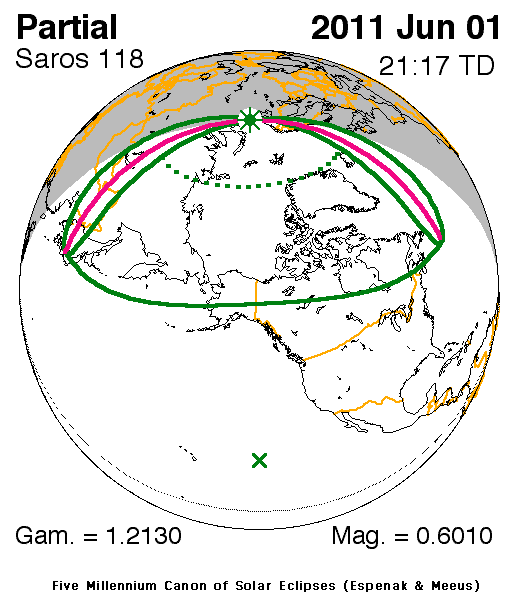|
You are here: Home > What's Up > Celestial Events > Partial Solar Eclipse of June 1st, 2011
Partial Solar Eclipse, June 1, 2011
On Wednesday, June 1, at the end of the afternoon (Quebec time) the Moon's shadow-cone will pass just above the Earth's North Pole. It won't be a total eclipse of the Sun, just a partial one, but it will be visible to varying degrees in the Arctic and neighbouring regions.
Eclipse visibility
 |
 |
|
General map of visibility of the 2011 June 1 partial solar eclipse.
Courtesy of Fred Espenak, NASA/GSFC.
|
|
|
The southern limit for viewing this partial eclipse will cut across Quebec diagonally: From James Bay, this imaginary line passes close to Chibougamau, and just north of lac Saint-Jean; it cuts across the St. Laurence River near Saint-Siméon in the Charlevoix, and Rivière-du-Loup on the south shore. In all regions situated north and east of this line, a partial solar eclipse will be visible. The Gaspé Peninsula, Magdalen Islands, the North Shore and Nunavik, plus Prince Edward Island, Newfoundland, and the northern half of New Brunswick and Nova Scotia, will all be within this zone.
However, throughout most inhabited areas, the eclipse will be somewhat inconspicuous. On the North Shore, for example, during the maximum phase, barely 3 percent of the Sun's surface will be obscured by the Moon: just visible to the naked eye, using solar filters specially designed for observing eclipses. To really see the tiny dent at the Sun's edge, caused by the Moon's silhouette, you'll need an optical instrument (binoculars or a telescope) equipped with a solar filter. In the far north of Québec, the eclipse will be more pronounced, though it won't exceed 11 percent.
Local Circumstances for the 2011 June 1 Partial Solar Eclipse
|
|
Begins |
Maximum |
Ends |
Magnitude* |
Obscuration* |
Québec (EDT)
|
|
|
|
|
|
| Rimouski |
18:30 |
18:43 |
18:55 |
0.0198 |
0.33 % |
| Matane |
18:26 |
18:42 |
18:58 |
0.0345 |
0.76 % |
| Gaspé |
18:21 |
18:41 |
19:02 |
0.0573 |
1.62 % |
| Bonaventure |
18:26 |
18:43 |
18:59 |
0.0371 |
0.84 % |
| Tadoussac |
18:37 |
18:43 |
18:50 |
0.0060 |
0.06 % |
| Baie-Comeau |
18:25 |
18:41 |
18:58 |
0.0346 |
0.76 % |
| Sept-Îles |
18:17 |
18:39 |
19:01 |
0.0650 |
1.96 % |
| Havre-Saint-Pierre |
18:14 |
18:39 |
19:03 |
0.0857 |
2.95 % |
| Natashquan |
18:12 |
18:39 |
19:04 |
0.0979 |
3.59 % |
| Fermont |
18:07 |
18:35 |
19:02 |
0.0999 |
3.71 % |
| Chisasibi |
18:16 |
18:33 |
18:49 |
0.0317 |
0.67 % |
| Schefferville |
18:00 |
18:31 |
19:02 |
0.1315 |
5.56 % |
| Kuujjuaq |
17:49 |
18:25 |
19:00 |
0.1680 |
7.99 % |
| Salluit |
17:38 |
18:17 |
18:54 |
0.1824 |
9.02 % |
|
|
|
|
|
|
Magdalen Islands, QC (ADT)
|
|
|
|
|
| Cap-aux-Meules |
19:23 |
19:43 |
20:02 |
0.0538 |
1.47 % |
|
|
|
|
|
|
Atlantic Provinces (ADT)
|
|
|
|
|
|
| Moncton |
19:37 |
19:46 |
19:54 |
0.0099 |
0.12 % |
| Charlottetown |
19:32 |
19:45 |
19:59 |
0.0253 |
0.48 % |
| Sydney |
19:26 |
19:44 |
20:02 |
0.0465 |
1.19 % |
|
|
|
|
|
|
Newfoundland (NDT)
|
|
|
|
|
|
| St. John's |
19:41 |
20:09 |
20:37 |
0.1237 |
5.08 % |
|
|
|
|
|
|
Nunavut (EDT)
|
|
|
|
|
|
| Iqaluit |
17:31 |
18:14 |
18:56 |
0.2413 |
13.6 % |
|
|
|
|
|
|
North Pole (UT)
|
20:27 |
21:21 |
22:14 |
0.4693 |
35.4 % |
* Notes: The magnitude of an eclipse is the fraction of the solar diameter that is covered by the moon at maximum eclipse. Obscuration is the percentage of the solar surface area that is hidden by the moon at maximum eclipse.
|
|
Observation
|
|
CAUTION!
Great care must always be taken when observing the Sun: Intense solar radiation can cause instantaneous burns to the retinas and permanent eye damage. When observing the Sun directly, either with the naked eye, or a telescope, one must always use specially designed solar filters.
Safe observing methods
|
|
Caution! One must never look toward the sun without using a proper solar filter, either with the naked eye or through an optical instrument.
If no suitable filter is available, the Sun’s image can also be projected on a screen with a pair of binoculars or small telescope. In this case, a filter should not be used. However, the setup must be monitored at all times to ensure that no one accidentally looks through the optics.
Under all circumstances, please follow these tips and techniques for a safe and enjoyable obervation of the eclipse.
More information...
Monthly Sky | Celestial Events | Ephemerides & Astronomical Data | Resources | Publications | Meteorites
About The Planetarium | Teachers & Educators | What's Up | Media | The Planetarium On The Road
Home | FAQ | Site Map | Reach Us | SAPM | Français
|